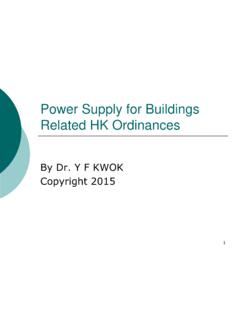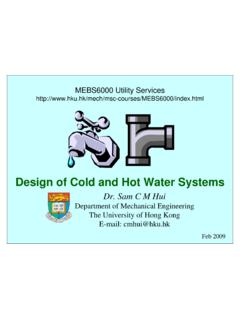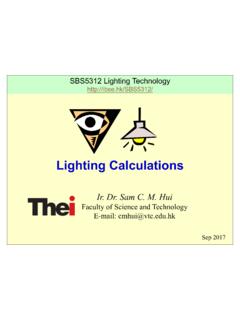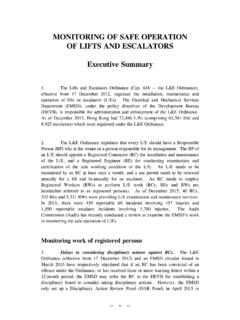Transcription of Lighting Energy Management - ibse.hk
1 Lighting Energy ManagementIr. Dr. Sam C. M. HuiFaculty of Science and TechnologyE-mail: 2017 SBS5312 Lighting Lighting Energy Use Energy Efficient Lighting Lighting Economics Existing Buildings Lighting Surveys & AuditsEnergy efficiency and costs are two important criteria for Lighting designLighting Energy Use Lightingconsumes a great share of Energy use in buildings Consumption of electricity Indirectly affect the cooling systems (due to heat) Operating & maintenance costs The need to manage the Lighting Energy Prevent Energy wastage & save Energy costs Ensure good quality visual environment Reduce greenhouse gas or CO2emission(Video: Lighting and the environment (1:59) ) Energy consumption patterns in offices and retails(Data source: Energy Efficiency Office, HK)Do you know what are the direct and indirect Energy consumption of Lighting ?
2 Space cond54%Lighting14%Others19%Office equipment13%Offices(2012)Space cond37%Lighting24%Others39%Retails(2012) Energy consumption patterns in offices and retails(Data source: Energy Efficiency Office, HK)Space cond48%Lighting19%Others11%Office equipment22%Offices(2007)Space cond39%Lighting38%Others23%Retails(2007) Do you know why the Lighting contribution % varies between 2012 and 2007? Lighting Energy Use HK Building Energy code (BEC)* code of Practice for Energy Efficiency of Building Services Installations 2015 Edition & 2012 Edition Technical Guidelines on Building Energy code 2015 Edition & 2012 Edition Energy Efficiency Labelling Scheme (HK)* Compact fluorescent lamps (CFLs), LED(* See also )(Source: EMSD)(See details)(Source: EMSD)(See details) Energy Efficient Lighting HK Building Energy code : Energy efficiency requirements for lightinginstallation 1.
3 Lighting power density (LPD) Reduce Lighting power 2. Lighting control point Facilitate effective operation; reduce Energy use 3. Automatic Lighting control Such as daylight responsive control, occupant sensor, time scheduling, dimmer control system(Source: BEC 2015)(Source: Technical Guidelines on Building Energy code 2015)Sample calculation for Lighting power density (LPD) Energy Efficient Lighting Typical Lighting requirements Minimum allowable luminous efficacy Choose appropriate type of lamps Maximum allowable lamp controlgear loss Energy efficient ballast for fluorescent lamps Maximum allowable Lighting power density (LPD) Design suitable amount and type of Lighting systems Interior Lighting controls(switching) Number of control points (to facilitate effective operation) Energy Efficient Lighting Lighting efficiency principles: 1.
4 Lighting hardwareefficiency Includes light source, control gear, optical system, luminaire housing, etc. 2. Lighting installationefficiency Largely dependent on the choice, location, and setting up ( aiming) of the Lighting hardware 3. Usageefficiency Depends largely on the type of Lighting controlsEvolution of light bulbsEdison lampIncandescent lampCompact fluorescent lampLED lampEnergy Efficient Lighting Video: Energy 101: Light Bulbs(4:47) Our animated correspondent, Little Lee Patrick Sullivan, kicks off our Energy 101 series with an inside look -- literally -- at light bulb technology. He goes inside an incandescent, a compact fluorescent and an LED bulb to see what makes them work, and their potential Efficient Lighting Principles of efficient Lighting design Meet target light levels Efficiently produce light Use natural light or efficient light sources Efficiently deliver light Balance efficiency with aesthetics, Lighting quality, visual comfort Automatically control Lighting operation Switch off or dimunnecessary Lighting equipmentEnergy efficientfittings ( compactfluorescent lamps, LED) Lighting controls andinteractions with windowsEnergy efficient Lighting design strategiesVertically Integrated DesignPersonal Control Features: Direct/ Indirect Pendant Luminaire Task light: 2T8-PS Dimmable EB (64W)/ 100%-5% Ambient light.
5 1T8-PS EB (31W)/ ON/OFF only Photocell Sensor built in Occupancy Sensor built inExample: Integrated controls for Lighting luminairesComparison to a Standard Troffer Layout:(Source: ) Energy Efficient Lighting The key is to understand Lighting needs & operation Space design & utilisation Daylighting potential Light sources Luminaires Lighting controls Operation & maintenanceEnergy Efficient Lighting Recommendations by IESNA Design Lighting for expected activity (higher light levels for "working , lower levels for "walking") Design with more effective fixtures & fenestration Use efficient light sources (higher lumen per watt output) Use more efficient fixtures Use thermal controlled fixtures Use lighter finish on ceilings, walls, floor & furnishingsEnergy Efficient Lighting Recommendations by IESNA(cont d) Use efficient incandescent lamps Turn off lights when not needed Control window brightness Use daylighting as practicable Keep Lighting equipment clean and in good working condition Post instructions covering operation & maintenanceLighting Economics Lighting system ---life cycle costs (LCC) Initial costs Equipment, installation, wiring, HVAC Energy costs Direct Lighting costs Energy use (kWh) = Lighting power (kW) x operating time (hr) Lighting -related HVAC (indirect) costs Lighting heats up the space & require cooling Total cost savings = Energy costs + demand costs Maintenance costs(Video: What does Lighting cost (4.))
6 30) ) Lighting Economics Lighting maintenance Relamping Reballasting Cleaning Miscellaneous maintenance replace lenses or louvers, damaged parts Insurance & property taxes DepreciationLighting Economics Investment costs Luminaire, including control gear (where applicable) Lighting control systems ( dimmers) Mounting accessories Electrical wiring Installation costs Running costs Energy Lamp replacement Maintenance Amortization (disposal)(Video: Economics of Light (3:22) )Payback period of Lighting scheme[Source: Thorn Lighting ]A. 75%B. 80%C. 85%D. 90%Replace a 60 W incandescent light bulb with a 9 W compact fluorescent lamp will generate how much electrical Energy saving? Lighting Economics Economic analysis techniques: Payback (simple, discounted) Escalating costs, future costs Principles of life cycle costing (net present value) Investment analysis Total life cycle cost Payback Return on investment (ROI) Lighting analysis software: Lighting design, Energy auditing, building simulation, economic analysis(Video: Lighting Economics (4:53) )[Source.]
7 Thorn Lighting ]Shall not overlook staff productivityExisting Buildings Energy Management for existing buildings Building survey Power budget & limit determination Energy limit determination Energy limit analysis Critical issues to consider Maintenanceof Lighting system Lighting upgradestrategies EnvironmentalaspectsExisting Buildings Maintenance of Lighting system Periodic cleaning of Lighting fixtures & lamps Decreases light loss & improve light levels Spot or group replacement of lamps based on the economics of the system Periodic repainting or cleaning of the room surfaces (ceiling, walls, and floor) to maintain optimum light reflection characteristics Concept of lumen maintenance (See also: Maintenance Factor : Taking the reduction of luminous flux into )[Source: Thorn Lighting ]Lamp maintenance effect[Source: Thorn Lighting ]Lamp maintenance effect[Source: Thorn Lighting ]Existing Buildings Common Lighting upgrade strategies Upgrade with reduction in light levels If original design is excessive Increase light levels Maintain light levels Focus light levels Task lights or accent Lighting Reduce hours of use Add time schedule or automatic controlsExisting Buildings Upgrading fluorescent fixtures Improved fluorescent lamps T-8, T-10.
8 T-12 tri-phosphor lamps New T-5 lamps New induction lamps (long life) Electronic ballasts Standard non-dimmable Consider dimming balasts New programmable balasts ReflectorsExisting Buildings Typical fluorescentfixture upgrades T8 lamp/ballast system T5 twin-tube lamp/ballast system Specular reflectors/delamping Current limiters Daylight-dimming systems 25W T12 lamps/T8 ballasts Premium magnetic, cathode cut-out (hybrid), electronic ballasts (full output, dimmable, light-level switching and low-wattage) Lens/Louvre upgrades Indirect Lighting w/task Lighting Task Lighting w/reduced ambient Lighting New fixturesExisting Buildings Compact lightingupgrades Compact fluorescent lamps Halogen lamps Krypton incandescent lamps Electrodeless downlight lamps Compact HID lamps New fixtures High-intensity discharge (HID) lightingupgrades Energy -saving metal halide and high pressure sodium (HPS) lamps Switching to metal halide or HPS systems HID fixture reflectors High-bay compact fluorescent lamps Dimming ballasts New fixturesExisting Buildings Typical exit signupgrades Compact fluorescent lamps Low-wattage incandescent lamps LEDs Electroluminescent panels New exit signs Typical controlupgrades Lighting Management systems Dimmable fluorescent & HID ballasts Daylight- & lumen maintenance-dimming systems Electronic timeclocks Occupancy sensors (many options available) Manual, step-level & panel-level dimming systems Current limiters Capacitive-switching HID systemsExisting Buildings Lighting retrofit economics ($$$) Must understand current Energy consumption Payback & return on investment (ROI) Simple payback usually Life cycle cost (LCC)
9 Analysis Impact of Lighting on building HVAC Lighting & HVAC interactions Cooling Energy savings(Video: What is 1 watt? (4:52) )Existing Buildings Other considerations: Calculate Energy usage and costs Power quality: power factor & harmonic distortion Daylighting Lighting vs. HVAC Energy audit & Lighting studies Economic analysis Load shape impactsExisting Buildings Environmental aspects of Lighting Disposal Lighting waste disposal ( lamp & ballast) Green lights Minimum efficacy standards for lamps Emissions ( mercury) During manufacturing During operationLighting Surveys & Audits Major tasks: Collect financial information Utility rate & tariff structure, average charges for Energy (kWh) and demand (kW), rebates or subsidies Collect general information Floor plans, reflected ceiling plan, room dimensions Collect occupant information How they feel about the Lighting systemLighting Surveys & Audits Major tasks: (cont d) Collect Lighting information Hours of operation Type, size & nos.
10 Of fixtures Nos. of lamps per fixture, no. of lamps per ballast Type of lamps, type of ballasts, specular reflectors (if any) Fixture condition, whether fixtures are air-handlers Availability of daylight Tasks performed in the space Use of partitions Unique fixture types or physical features Area dimensions, height of the tasks, fixture mounting height Surface reflectances, colours of major objects & room surfacesLighting Surveys & Audits Instrumentation Illuminance measuring equipment Luminance measuring equipment Daylight factor meters Survey methods Number of measuring points Presentation of information Method of evaluating daylight & artificial Lighting Calculation using lumen methodLighting measuring equipmentMinolta Illuminance Meter T-10 (luxmeter)Minolta Luminance Meter LS-110( ) Lighting Surveys & Audits What to look for?














